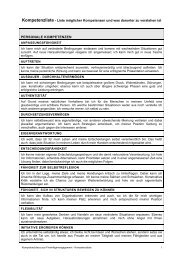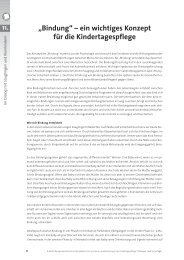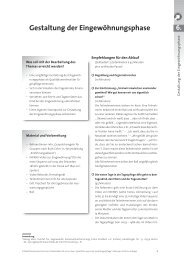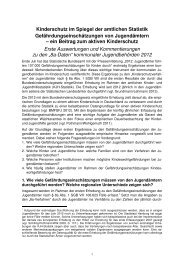Prevention of Right-Wing Extremism, Xenophobia and Racism in ...
Prevention of Right-Wing Extremism, Xenophobia and Racism in ...
Prevention of Right-Wing Extremism, Xenophobia and Racism in ...
Create successful ePaper yourself
Turn your PDF publications into a flip-book with our unique Google optimized e-Paper software.
For each specifi c fi eld, the the <strong>in</strong>teraction between the actor <strong>and</strong> context po<strong>in</strong>t to a different<br />
<strong>in</strong>tervention approach that takes these conditions <strong>in</strong>to account. It is important to note that the<br />
category <strong>of</strong> right-w<strong>in</strong>g extremist actors also <strong>in</strong>clude adults.<br />
We proceed from the hypothesis that each <strong>of</strong> the fi elds I through IV has its own dynamics<br />
<strong>and</strong> thus requires appropriate methods <strong>and</strong> <strong>in</strong>tervention strategies that follow specifi c orien-<br />
tations:<br />
I. In this situation extremists are rather isolated. The preferred strategy is thus a compre- compre-<br />
hensive approach, focus<strong>in</strong>g on prevention <strong>and</strong> dialogue, as both young people <strong>and</strong> their their<br />
environments are mostly characterized by tolerant attitudes. The aim <strong>of</strong> this sensitization<br />
<strong>and</strong> <strong>in</strong>formation is to see young people distance themselves from xenophobic positions.<br />
II. As the environment lacks underst<strong>and</strong><strong>in</strong>g for, <strong>and</strong> thus rejects right-w<strong>in</strong>g extremist youth,<br />
these youngsters are <strong>in</strong> a m<strong>in</strong>ority position. The “accept<strong>in</strong>g” approach is appropriate here,<br />
tak<strong>in</strong>g the young people seriously <strong>and</strong> address<strong>in</strong>g their specifi c social problems.<br />
III. In a context <strong>of</strong> latent latent approbation or support <strong>of</strong> right-w<strong>in</strong>g activities, it is diffi cult to de fend<br />
the rights <strong>of</strong> ethnic m<strong>in</strong>orities. This calls for a strategy <strong>of</strong> strengthen<strong>in</strong>g m<strong>in</strong>orities <strong>in</strong> con-<br />
text, through sensitiz<strong>in</strong>g the majority (rather than the youth) <strong>in</strong> order to achieve <strong>in</strong>crea sed<br />
acceptance <strong>of</strong> the m<strong>in</strong>orities suffer<strong>in</strong>g most <strong>in</strong> the <strong>in</strong>tolerant climate.<br />
IV. In this context, the position <strong>of</strong> educators is the most delicate, for their latent or open sup- sup-<br />
port <strong>of</strong> right-w<strong>in</strong>g extremist youth can make them relatively isolated <strong>in</strong> the environment.<br />
For this reason, the primary strategy is de-escalation, empowerment, <strong>and</strong> targeted victim<br />
support, as it is necessary here to de-escalate violence perpetrated by youth, to mobilize<br />
<strong>and</strong> sensitize decision-makers <strong>and</strong> “social multipliers” amplify<strong>in</strong>g the <strong>in</strong>fl uence <strong>of</strong> the given<br />
<strong>in</strong>tervention <strong>in</strong> the population, while at the same time provid<strong>in</strong>g support to m<strong>in</strong>orities <strong>and</strong><br />
possible victims.<br />
Without doubt, fi eld IV is the most diffi cult for effective <strong>in</strong>tervention, as both negatively char- char-<br />
ged components, namely, youth <strong>and</strong> environment, recharge <strong>and</strong> re<strong>in</strong>force each other. This<br />
means that it is essential to exam<strong>in</strong>e <strong>and</strong> analyze the situation <strong>in</strong> depth prior to tak<strong>in</strong>g <strong>in</strong>itial,<br />
careful steps steps towards contact<strong>in</strong>g key, anchor<strong>in</strong>g persons <strong>and</strong> attempt<strong>in</strong>g to raise their awareness<br />
<strong>of</strong> <strong>and</strong> sensitize them to the problems. There are many different levels that must be <strong>in</strong>-<br />
cluded <strong>and</strong> empowered: social decision-makers <strong>and</strong> responsible parties, m<strong>in</strong>orities, potential<br />
victims, parents, youth, <strong>and</strong> so on.<br />
Consequently, rather than defi n<strong>in</strong>g right-w<strong>in</strong>g extremism primarily as a problem <strong>of</strong> youth,<br />
it is better defi ned as a problem <strong>of</strong> our society as a whole. Accord<strong>in</strong>gly, <strong>in</strong>tervention must ad-<br />
dress the entire environment. After precise analysis <strong>of</strong> the right-w<strong>in</strong>g extremist scene <strong>in</strong> situ,<br />
the responsible political <strong>and</strong> social authorities, persons, <strong>and</strong> <strong>in</strong>stitutions will be provided with<br />
<strong>in</strong>formation on the forms <strong>of</strong> expression, causes, <strong>and</strong> roots <strong>of</strong> right-w<strong>in</strong>g extremism. Aids to<br />
argumentative competence will be provided <strong>in</strong> order to strengthen all <strong>in</strong>volved parties’ confl ict<br />
resolution competence <strong>and</strong> democratic ability, <strong>in</strong> the sense <strong>of</strong> empowerment. Moreover,<br />
through <strong>in</strong>clud<strong>in</strong>g victims <strong>and</strong> potential victim groups, the spectrum <strong>of</strong> <strong>in</strong>tervention is exp<strong>and</strong>- exp<strong>and</strong>-<br />
38 The Special Case <strong>of</strong> Switzerl<strong>and</strong>

















